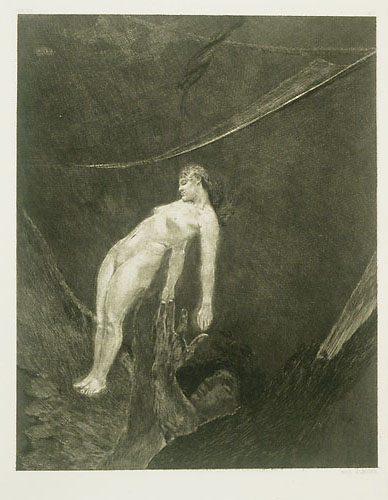|
Max Klinger
German, 1857-1920
Ins Nichts zuruck (Back into Nothingness),
Plate 15 from the cycle Ein Leben (A Life),
1884,
Etching and aquatint on heavy cream wove paper, fourth edition
Museum purchase
1996.24
Toward the end of the nineteenth century, artists like Klinger dramatized the contradictions of extreme realism and dreamy symbolism, love and death, male and female, tradition and revolution, socialism and individualism, the increasing power of our human will and our increasingly eerie passivity. Despite his addiction to the fearless honesty of fantasy, Klinger influenced the social realism of Käthe Kollwitz. Both were obsessed with the deeper truth-telling of the dark inkiness of the print. Both were ecstatically sympathetic with the doomed heroism of motherhood, and both were furious with what they saw as the heartlessness of the middle class. This image is the last scene in a series of prints about a woman's life. She is the victim of a faithless lover and a society faithful only to hypocrisy and malice. In the end, like Käthe Kollwitz herself, she is perhaps content to be received into the giant dark peace of Nothingness, who alone holds out powerful hands to her. Her long hair which linked her to life is being severed by a scythe. Like Kollwitz, Klinger is monumental even in his supremely graphic quality because, like her, he was also a sculptor.
